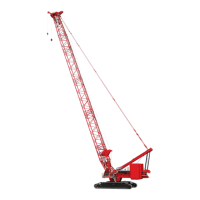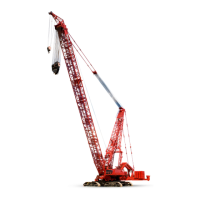LUBRICATION GUIDE MLC80A-1/MLC90A-1/MLC100A-1/MLC100-1
F2314-4
07-20-21
CYLINDER ROD LUBRICATION
The cylinder rods on Manitowoc cranes have a layer of
chrome plating on their surfaces to help protect them from
corrosion. Inherently, however, the chrome plating has
cracks in its structure which can allow moisture to corrode
underlying steel.
Depending on ambient temperature and the frequency of
cylinder operation, the crane’s hydraulic oil may not
penetrate these cracks and protect the rods. Even if the
cylinders are operated on a regular basis, many cylinders
have portions of exposed rod even when the cylinders are
fully retracted.
Exposed cylinder rods on cranes that are stored, trans-
ported, or used in inclement environments (high humidity,
rain, snow and salt air) are at high risk of corrosion.
All exposed cylinder rods must be protected by applying a
thorough coat of cylinder rod protectant, available from
Manitowoc in 12 oz. aerosol cans (Part No. 9999101803).
One can of the protectant is provided in the Parts Box
supplied with the crane.
The cylinder rod protectant contains solvents and lubricants
that penetrate metal pores, displace moisture, dissolve
existing corrosion and then dry to a resilient, waxy coating.
Cylinder operation and weather will remove the protectant
over time. Therefore, inspect all cylinder rods weekly and
reapply protectant to exposed rods.
ENVIRONMENTAL PROTECTION
Dispose of waste properly Improperly disposing of waste
can harm the environment.
Harmful waste used in Manitowoc cranes includes—but is
not limited to—oil, fuel, grease, coolant, air conditioning
refrigerant, filters, batteries, and cloths which have come into
contact with these substances.
Handle and dispose of waste according to local, state, and
federal environmental regulations.
When filling and draining crane components, do not pour
waste fluids onto the ground, down any drain, or into any
source of water.
• Always drain waste fluids into leak-proof containers that
are clearly marked with what they contain.
• Always fill or add fluids with a funnel or a filling pump.
• Immediately wipe up any spills.
REFERENCE INSTRUCTIONS
See the Service Manual for detailed information on specific
maintenance checks and procedures.
HYDRAULIC FILTER REPLACEMENT
For instructions, refer to Section 2 of the Service Manual.
Hydraulic filter elements on this crane are specially designed
to withstand high pressure as the elements fill with dirt. This
feature prevents the elements from collapsing.
LUBRICATION POINTS
• See Figure 3, page 7 for the location of the engine
components.
• See Figure 4, page 8
through Figure 8, page 14 for the
location of the lubrication points in the upperworks and
lowerworks.
• See Figure 10, page 16
for the location of the lubrication
points in the boom.
The letters before the item numbers in the illustrations
correspond to the following intervals:
• A = At Assembly
• D = Daily
• W = Weekly
• M = Monthly
• Q = Quarterly
• S = Semiannually
• O = At Overhaul
• Y = Yearly
• B = Biennial (every two tears)
CRANELUBE
Manitowoc highly recommends using CraneLUBE lubricants
to increase your crane’s reliability and performance. Contact
your Manitowoc dealer for information about the Manitowoc’s
CraneLUBE lubrication program.
Refer to the Lube and Coolant Product Guide after this
publication for lubricant container sizes and part numbers.
CAUTION
Hydraulic System Damage
Original Equipment Manufacturers’ filter elements—
available from Manitowoc—must be used on this crane.
Substituting with any other brand or type filter element is
prohibited.
Filter elements made by other manufacturers may
collapse under pressure. This action will allow unfiltered
oil to be drawn into hydraulic system—pumps, motors,
and valves can be destroyed.
Manitowoc will reject warranty claims for damaged
hydraulic components if proper hydraulic filter elements
are not used.

